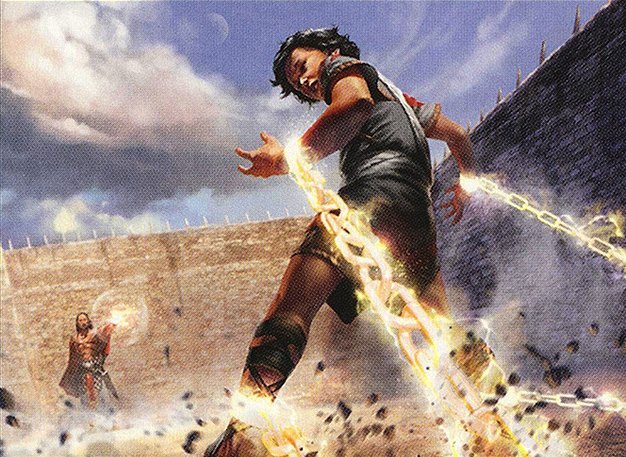Hello friends! Today we'll talk about a format which may please players who enjoy Pauper and Limited, especially those who like Draft, and which may catch the eye even of those who don't play either of them, because it is a very fun and diverse format.
Cube Draft is a limited format in which, generally, the best cards in Magic see play. Boosters are created from a pool of cards and the participants take turns choosing the cards, like a normal Draft. However, Cube allows for more freedom, as players may build their own Cube and, considering that, we can build a Cube using just common cards. And, of course, we can use Pauper Staples and also add cards which don't usually see competitive play.
While building we have to be careful not to create an unbalanced Cube. The interesting thing is to add cards with synergy with one another and which may find answers within their own Cube. As it may be complicated to build a list from scratch, below you will find lists separated by color, artifacts, multicolored and lands, and these are updated lists, to make it easier for you. It's important to notice that when new cards are released, some may be replaced on these lists.
WHITE
BLUE
BLACK
RED
GREEN
COLORED
UNCOLORED
ARTIFACTS
LANDS
Playing with the cube
You build the shuffled Cube previously and then separate 15 cards semi-randomly, trying to include at least one nonbasic land in each booster. Then, each participant receives 3 boosters (you don't need to seal them - just give them the 15 card pile), which represents 45 cards for each player. From there, it works like a normal Draft. Players take turn in choosing cards, passing their boosters and receiving new ones from the other players.
A part of drafting is the strategy of trying not only to pick good cards for your deck, but also to think about which cards your opponents are choosing and how you may thwart their plans, like choosing a card which the next player would probably pick.
When you are finished with these picks, you will have 45 available cards to build your deck.
Building the decks
Many players already have their own deckbuilding techniques for limited play. However, if you need some tips to get started, here are they:
1. Look for removals, of any cost, because they will be essential when dealing with the opponent's threats.
2. Seek cards which offer card advantage, as drawing may make a difference during the endgame.
3. Try to build a deck on a mana curve. At least for the first turns, try to find creatures that cost 1 and 2 (at least 8 creatures on this combination). If that isn't possible, add another type of permanent on this curve, but one that is still useful to your game plan.
4. Have at least 2 bombs. Bombs are cards which may win the game quickly, or assist you in ending it. Generally, these are 4/4 or 5/5 creatures.
5. Use 16 or 17 lands in your deck. As it will contain 40 cards, you will have 23 or 24 slots left to develop your strategy.
6. The minimum limit of cards in a Limited Deck is 40. Try not to go over this limit, as more cards may make it harder for the right cards to be draw.
7. Choose two colors, if possible. You will hardly build a monocolored deck, so two colors may be the most viable option. You may even add a third color to use one or two valuable cards in your deck, but if you exaggerate, you may end up not being able to access the right mana colors when you need them.
8. Know the cards of the Cube. It may assist you to think about what you will be playing against and also assist you to plan your objectives during your draft picks.
An important detail: All cards you have selected during the draft process and that weren't used in your main deck may be used as sideboard.
Calculating mana/lands
There is a way to calculate the amount of lands of each color the player will need to use in his/her deck efficiently. For that, some steps need to be follow. Below each step, we'll give an example of a fictional deck we'll be building, with the intention of making the process easier to understand.
Step 1: Choose the number of lands, usually 16 or 17. This includes nonbasic lands.
Example: 17. We'll add 1 Desert, so we'll need 16 more lands.
Step 2: Count the mana symbols of your spells and note the number separately for each color.
Example:
Black: 6;
Green: 8;
Red: 7;
Total: 21.
To calculate the cost percentage of each color, we'll use a simple cross-multiplication:
Mana Color: MC
Total Cost: TC
Percentage: P
Formula: MC X P = X ÷ TC = Mana Percentage
Black: 6x100=600, 600 ÷ 21 = 28,6%
Green: 8x100=800, 800 ÷ 21 = 38,1%
Red: 7x100, 700 ÷ 21 = 33,3%
Now that we know the mana percentage of each color, let's find the approximate number of lands for each color.
Mana Percentage: MP
Total Lands: T (16)
Total Percentage: 100
Formula:
MP X T = X, X ÷ 100 = Total amount of lands of the desired color.
Swamp: 28,6 x 16 = 457,6.
457,6 ÷ 100 = 4,6 approximately.
Forest: 38,1 X 16 = 609,6.
609,6 ÷ 100 = 6,1 approximately.
Mountain: 33,3 x 16 = 532,8.
532,8 ÷ 100 = 5,3 approximately.
In conclusion, we'll have 5 swamps, 6 forests and 5 mountains.
Here's our final list:
Conclusion
I hope this article has been both informative and suggestive, to the point of encouraging you to build your own cube, call your friends, and play.
That's it for today. I thank Cards Realm for the support and trust. I also thank Vipermats Custom Mats. Create an account in Cards Realm using your Google or Facebook account and ask on the comments section for their 10% coupon code in any custom mat.
Thank you for reading and until the next article!















— Comments 0
, Reactions 1
Be the first to comment